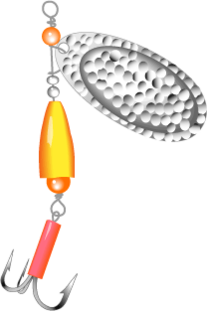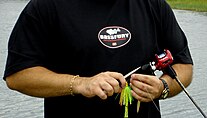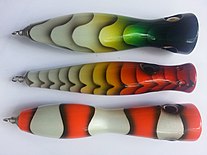
Back Блесна Bulgarian Kunstköder German Lant Estonian Arrantza apeu Basque دام ماهیگیری Persian Viehe Finnish Umpan tiruan ID ルアー Japanese Umpan gawean JV 루어 낚시 Korean
A fishing lure is any one of a broad category of artificial angling baits that are inedible replicas designed to mimic prey animals (e.g. baitfish, crustaceans, insects, worms, etc.) that attract the attention of predatory fish, typically via appearances, flashy colors, bright reflections, movements, vibrations and/or loud noises which appeal to the fish's predation instinct and entice it into gulping the lure. Angling activities using lures are known as lure fishing.
As a terminal tackle, lures are attached to the end of a fishing line and most are equipped with one or more hooks that come in various styles (most commonly treble hooks). They are designed to be fake foods that fool carnivorous fish into an aggressive strike, the force of which will alert the fisherman to yank the line and secure a hookset inside the fish mouth. However some hookless lures are also used merely to bait the fish nearer, so it can be hooked by another lure or be captured via other means such as netting, trapping, impaling with a spear or pole hook, snagging, shooting or even catching by hand.
Most lures are commercially made, but some are hand-made by the angler (such as hand-tied fly lures, which is considered a hobbyist challenge by many amateur entomologists). Modern lures are typically cast and manipulated with a fishing rod and retrieved with a reel, but there are some who use a technique where the line is directly held with hands (known as handlining) rather than manipulated through a rod. Longlining and trolling, commonly used for commercial fishing, also can employ lures to catch fish. When used for recreational fishing, the lure is repeatedly cast out far and then reeled back towards the angler, and during retrieval it interacts with the water current and drag, creating vibrations, turbulent splashes and/or a popping action. A skilled angler can explore many possible hiding places for fish through lure casting under logs, grass and on flats.




